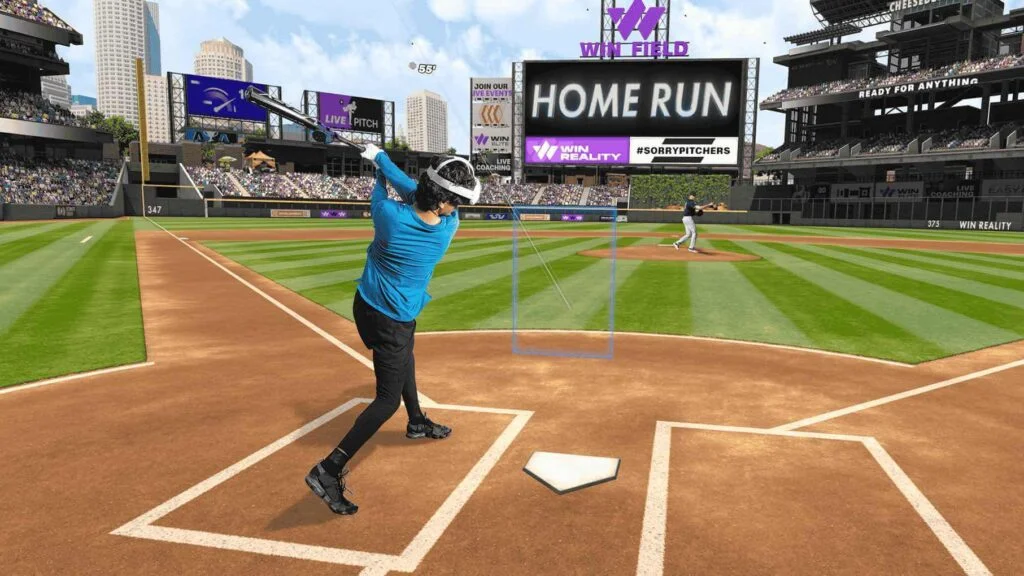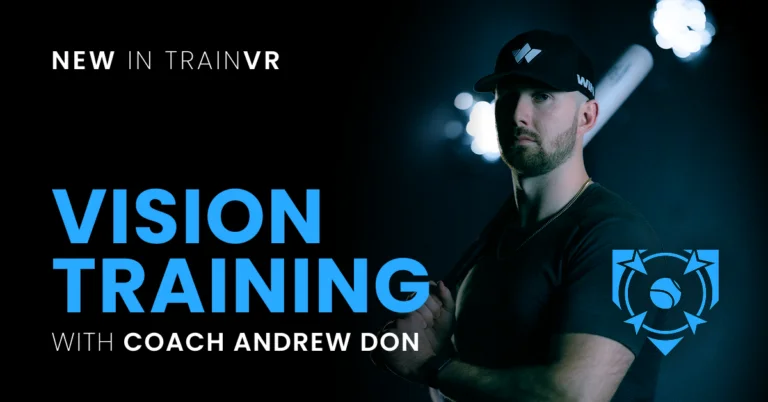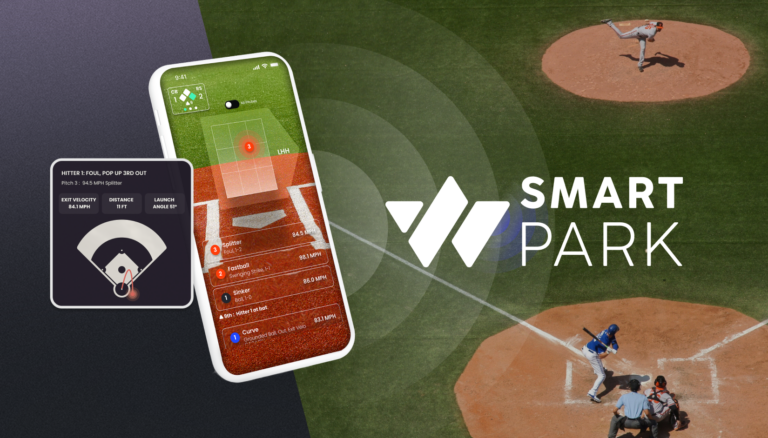The Short Answer:
| Age | Average Player Max | Elite Player Max |
| 8-10u | 45-55 mph | 55-65 mph |
| 11-12u | 55-60 mph | 60-70 mph |
| 13-14u | 60-65 mph | 65-75 mph |
| JV – 15u | 70-80 mph | 75-85 mph |
| Varsity – 16-18u | 85-90 mph | 90-100 mph |
| College | 95-100 mph | 100-110 mph |
| Pro | 105-110 mph | 115-120 mph |
Exit velocity, or “exit velo,” refers to the speed at which the ball leaves the bat after contact. Measuring how hard a hitter is capable of hitting the ball provides valuable insight into their ability to hit for power and do damage. Exit velocity is a big piece of the puzzle when comparing yourself to others at your level, and it plays a critical role in determining if you have the potential to compete at the next level.
While hitters are often told not to focus on batting average – since it’s influenced by factors beyond their control – they are consistently encouraged to prioritize hitting the ball hard. Exit velocity reflects a player’s ability to do just that. Higher exit velo often correlates with success in stats such as batting average, home runs, and extra-base hits.
Understanding how your exit velocity compares to average and elite players for your age is key to setting realistic goals and tracking progress. In this blog, we’ll break down average and top-end exit velocities at various levels, provide benchmarks, and offer strategies to boost your exit velo.
Breaking Down Exit Velo by Age
Monitoring exit velocity helps players assess where they stand in relation to their competition and those at higher levels. There’s a well-established correlation between exit velocity, batting average, and hitting for power. Simply put, the harder a ball is hit, especially within a launch angle between 7 and 22 degrees, the more likely it is to result in a hit.
While comprehensive data is primarily available at the big league level, the trend is clear: when a ball is hit at 96 mph or higher, batting average jumps to over .300. However, just 1 mph lower at 95 mph, it quickly drops to .265. This highlights the importance of hitting the ball hard if you want to increase your chances of getting hits. When it comes to extra-base hits, 30% of balls hit at 104 mph result in extra bases. That percentage climbs as exit velocity increases – reaching 72% at 119 mph.
These lessons apply to all levels of baseball: to give yourself the best chance of getting hits and hitting for power, there’s an exit velocity threshold you need to shoot for.
When breaking it down by age group, here are the typical ranges of maximum exit velocities we commonly see:
| Age | Average Player Max | Elite Player Max |
| 8-10u | 45-55 mph | 55-65 mph |
| 11-12u | 55-60 mph | 60-70 mph |
| 13-14u | 60-65 mph | 65-75 mph |
| JV – 15u | 70-80 mph | 75-85 mph |
| Varsity – 16-18u | 85-90 mph | 90-100 mph |
| College | 95-100 mph | 100-110 mph |
| Pro | 105-110 mph | 115-120 mph |
Keep in mind, these numbers represent the maximum exit velocities that both average and elite players are capable of hitting at each level — essentially their ceiling. However, hitting is hard, and most balls put in play are not fully squared up. As a result, the average exit velocity across a player’s full body of work is typically much lower, as it includes mishits.
Exit Velo Benchmarks You Should Shoot For
Setting exit velocity benchmarks helps track progress and drive improvement. Knowing the target exit velocity for your age and setting realistic goals can make a huge difference in your development. Using technology to measure exit velocity and other data is essential for establishing benchmarks and tracking progress. While not needed every session, periodic checks provide valuable feedback and help adjust your training plan as needed.
The biggest gains in exit velocity tend to occur during middle and high school years, as players experience growth and physical maturation at a rapid pace. However, individual progress can vary, and there are always exceptions. Setting personalized benchmarks based on your current abilities and goals will give you a clearer framework for improvement.
Here’s a rough framework to help you set exit velocity goals based on age group:
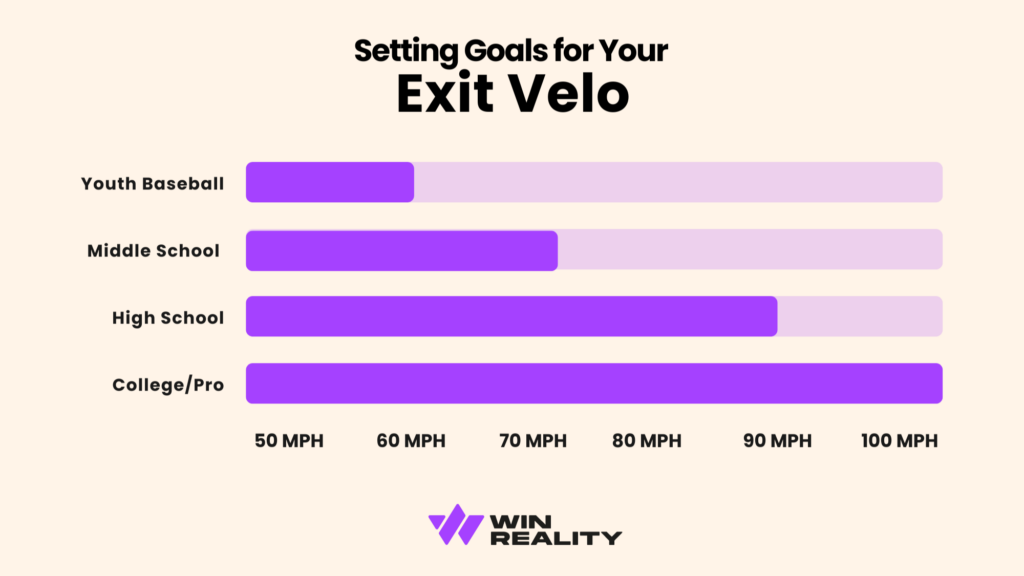
- Youth Baseball (Ages 8-12): Aim to reach a max exit velocity in the 60s by the time you hit 12u.
- Middle School (Ages 13-14): Target a max exit velocity in the 70s.
- High School Baseball (Ages 15-18): High school players should aim for an exit velocity in the 80s, but those aspiring to play at the next level should set their sights on reaching the 90s.
- College and Pro Baseball: For players looking to compete in college or professional baseball, most college hitters max out in the 90s, while elite college and major league baseball players consistently reach the 100s.
How to Improve Your Exit Velo
Skill #1: Increased Bat-to-Ball Skills = Increased Average Exit Velo
Several factors influence exit velocity, but there are two primary approaches to improving it. The first is getting better at squaring the ball up. While this won’t directly increase your maximum exit velocity, it will significantly improve your ball exit velocity, leading to greater on-field production.
Skill #2: Increased Bat Speed = Increased Max Exit Velo
The second approach is increasing bat speed. While it’s important at any age to swing with intent and improve how well you move, we don’t recommend specific max swing speed training before the age of 15.
For players aged 8-14, the primary focus should be on swinging hard with the intent to do damage, while also regularly evaluating their swing through biomechanics reports to ensure proper swing mechanics. During these early stages of development, the biggest gains in bat speed often come from moving more efficiently. As players enter middle school, they can begin to train to be more explosive with jumps, med ball throws, and sprints to further improve their athleticism.
By the time players reach high school, hitting the weight room becomes a top priority. The focus should be on strength training with heavy weights putting a focus on speed and power, along with continuing to become more athletic. At this stage, players should also begin specialized bat speed training.
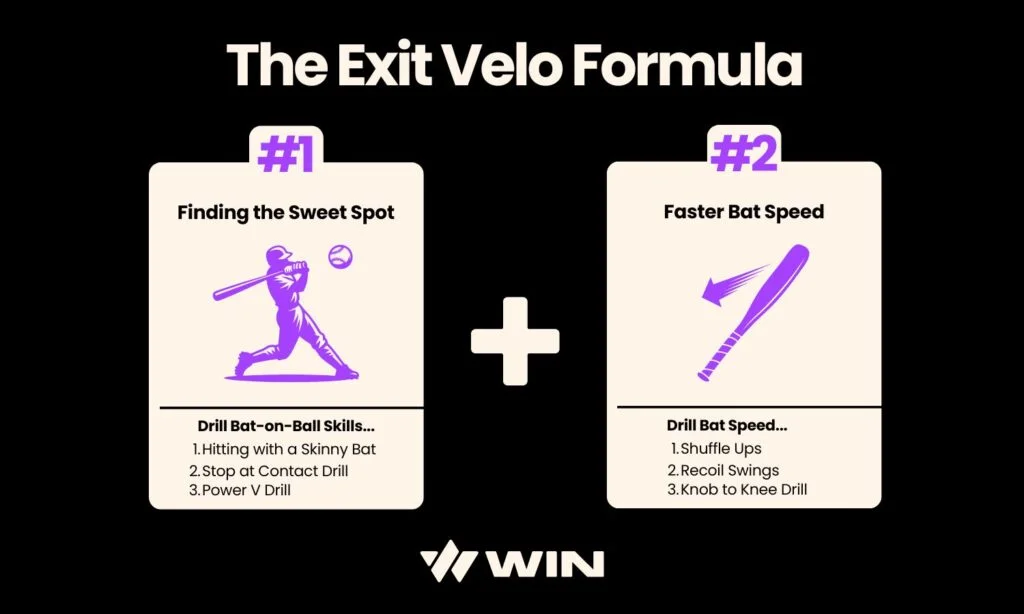
Drills to Improve Skill #1: Bat-to-Ball Skills
Below are some drills we recommend for improving bat-to-ball skills at all ages:
Hitting with a skinny bat
Hitting with a skinny bat is a great way to improve your bat-to-ball skills because it forces the hitter to be more precise with their ball striking.
Stop at Contact Drill
Hitters will improve contact quality by learning to stay inside and behind the ball, match the pitch plane, and stay connected throughout the swing.
Power V Drill
The Power V Drill is great for hitters who want to train to stay behind, inside, and through the ball.
Drills to Improve Skill #2: Bat Speed
Here are some great drills if you want to go the route of improving your bat speed:
Shuffle Ups
This drill will teach hitters how to generate momentum, move fast, and build bat speed.
Recoil Swings
This drill will force the hitter to turn tight, swing from the center of the body, and accelerate then decelerate the swing quickly. Mastering this is crucial for hitting the ball hard.
Knob to Knee Drill (with high intent)
Hitters will learn how to load, create separation, and gain momentum into the swing. This drill really emphasizes swinging with intent and looking to do damage.
Med Ball Shot Put & Scoop Toss
Both the scoop toss and shotput are great for hitters looking to learn how to move their body fast. Hitters will learn how to properly load and unload their bodies explosively in the proper sequence.
Whether you focus on improving bat-to-ball skills or increasing bat speed, incorporating these drills into your routine will help you achieve higher exit velocities over time.
How WIN Reality Can Help
Improving your exit velocity requires a combination of focused practice, strength training, and the smart use of technology – all while consistently testing and retesting. This is where WIN Reality can make a significant impact. WIN Reality is a complete player development platform designed to help players at every level reach their full potential by leveraging data-driven insights and getting reps against game-speed pitching.

Our revolutionary SwingAI Trainer tool provides in-depth feedback on your swing mechanics, using a simple “in-range” or “out-of-range” format to ensure you’re moving as efficiently as possible. Hitters receive personalized recommendations on what to work on along with drills designed to improve specific aspects of their swing. Over time, hitters can track their progress and receive feedback if key components of their swing start to fall out of range, helping prevent slumps before they happen.
The WIN Reality VR app allows you to train against game-speed pitching anytime, ensuring your mechanics transfer smoothly from the cage to the field. Paired with our mobile app, you can review stats, track your progress, and set targeted goals for boosting your exit velocity. With this suite of tools, you’ll be empowered to take your performance to the next level.
Leverage WIN Reality’s technology to elevate your game. Check out WIN Reality today and take the first step toward increasing your exit velocity!
GET STARTED